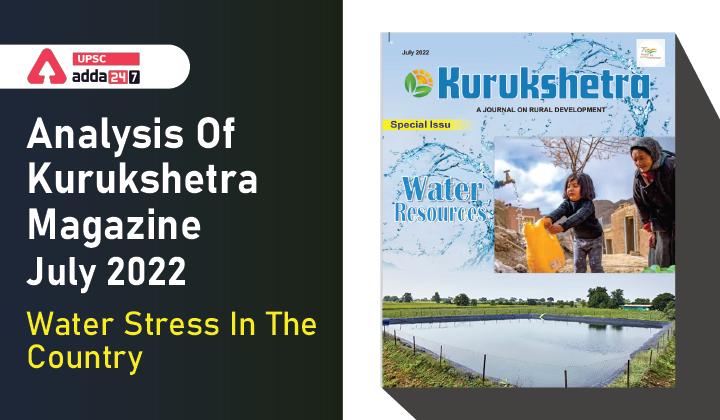Table of Contents
Kurukshetra is a Monthly Magazine which is issued by the Publications Division of the GOI.
Kurukshetra Magazine is one of the most important and indispensable source for UPSC Civil Services Exam Preparation. Keeping this in mind, here, we come with ”Analysis Of Kurukshetra Magazine” on daily basis, which covers the monthly Kurukshetra Magazine in easy and smooth pointed form, keeping in mind the demand of UPSC aspirants.
Considering the stern need of awareness regarding water resource management, the theme of this July 2022 special issue of Kurukshetra is Water Resources.
Water Stress In The Country: Introduction
- India houses 18 per cent of the world’s population but only 4 per cent share in water resources of the earth.
- India’s per capita water availability is expected to decline to 1,465 cubic metres by 2025, according to a recent ICAR study, and it’s a significant fall from 5,177 cubic metres in 1951.
- States like Uttar Pradesh, Rajasthan, Maharashtra, Tamil Nadu, Telangana and Haryana are already seeing water shortages.
Water Stress In The Country: Which Factors Limiting Water?
- On an average out of total precipitation that is 4000 billion cubic metres (BCM) about 1900 BCM of water remains available as natural runoff.
- However, due to geological and other factors, the utilisable water availability is limited only to 1137 BCM.
- Most of the rain falling on the surface runs off rapidly, leaving very little for the recharge of groundwater.
- This has become starker with erratic monsoons owing to climate change.
Water Stress In The Country: NITI Ayog’s Take
- According to NITI Ayog, a large number of Indians face high to extreme water stress. So, water has become a commodity as precious as gold in summers for people in India.
- While the Government of India is consistently working towards improving access to water, participation of local people and institutions is also the need of the hour.
Water Stress In The Country: Impact Of Water Crisis on Women
- The worst sufferer of this water-crisis is women. Fetching water in rural areas from long distances is considered as women’s duty from centuries.
- That’s why the role of Women in Water Conservation tags Jal Jeevan Mission as a blessing for women, as the objective of this mission is to provide Functional Household Tap Connections (FHTCs) to every rural household.
- Along with this the Jal Jeevan Mission has placed an emphasis on including women as decision-makers on water management, a role traditionally that has been denied to them.
Water Stress In The Country: IMD’s Data on Impact Of Climate Change
- The water cycle is undergoing drastic changes due to climate change and is driving more intense rainfall and flooding in certain areas, whereas certain other areas, generally further away
from coasts, are facing intense droughts. - India Meteorological Department’s analysis of rainfall data for the period 1971-2020 shows that the long period average (LPA) of south west monsoon declined by 1 cm and that of annual rainfall 1.7 cm, as compared to the 1961-2010 average.
- Shortage of 1 cm rainfall across the country means reduction of about 25 BCM to 30 BCM from the annually expected water availability which is equal to the quantum of water required to meet annual domestic water demand of 600 million people with 135 litres per day.
Water Stress In The Country: Our Agrarian Economy Needs Water
- Since India is an agrarian economy, a large fraction of our water is consumed in irrigation.
- Around 91 per cent of our water is used in the agriculture sector for irrigation.
- More than 60 per cent of this agricultural demand is met from groundwater, leading to a severe decline in groundwater levels.
- Therefore, water management in agriculture is very important.
- Importance of water management at source and participatory Irrigation Management for avoiding over-consumption of water, increasing the productivity of crops and for sustainable employment of local people.
Water Stress In The Country: Key Government Steps
- The government of India have adopted various measures to improve water use efficiency in the agricultural sector in the country.
- Per Drop More Crop (PDMC) component under Pradhan Mantri Krishi Sinchayee Yojana (PMKSY) mainly focuses on improving water use efficiency at the farm level through micro-irrigation and better on-farm water management practices to optimise the use of available water resources.
- State governments have also launched initiatives aimed at optimising water demand for agriculture. Examples are, ban on early sowing of paddy by Haryana and Punjab; ‘Jal Hi Jeevan Hai’ Scheme by Haryana to incentivise growing of less water intensive crops; and mandatory use of drip irrigation for sugarcane cultivation by Maharashtra Government.
- In addition to this, the Government also conducts mass awareness and public outreach programmes.
- Best practices for water conservation and enhancing water use efficiency are rewarded through institution of ‘National Water Awards’.
- Further, the National Water Mission, Ministry of Jal Shakti has launched the ‘Sahi Fasal’ campaign in November 2019 to nudge farmers in the water-stressed areas to grow crops which are not water intensive, but use water very efficiently; and are economically remunerative; are healthy and nutritious; suited to the agro climatic-hydro characteristics of the area, and are environmentally friendly.




 TSPSC Group 1 Question Paper 2024, Downl...
TSPSC Group 1 Question Paper 2024, Downl...
 TSPSC Group 1 Answer key 2024 Out, Downl...
TSPSC Group 1 Answer key 2024 Out, Downl...
 UPSC Prelims 2024 Question Paper, Downlo...
UPSC Prelims 2024 Question Paper, Downlo...





